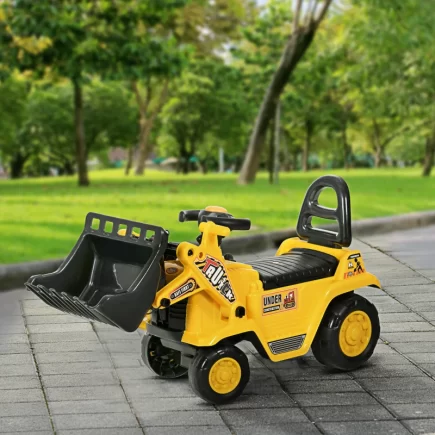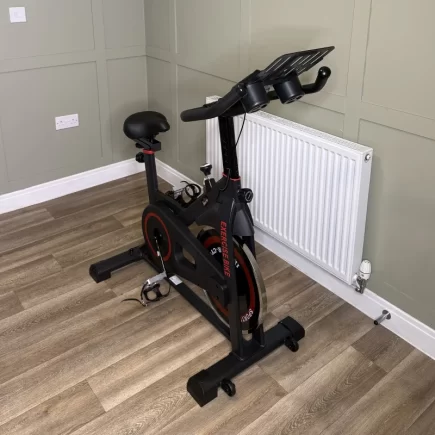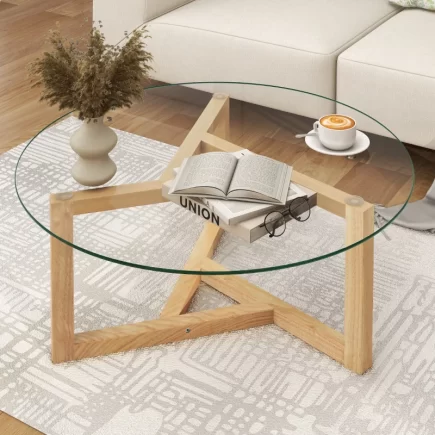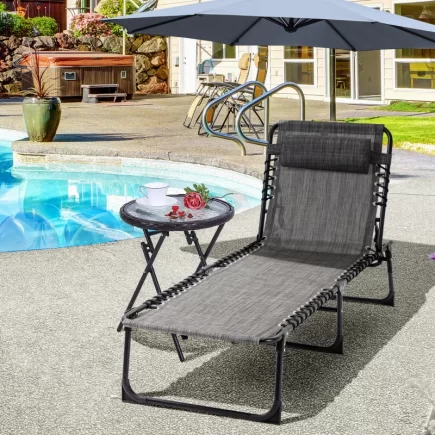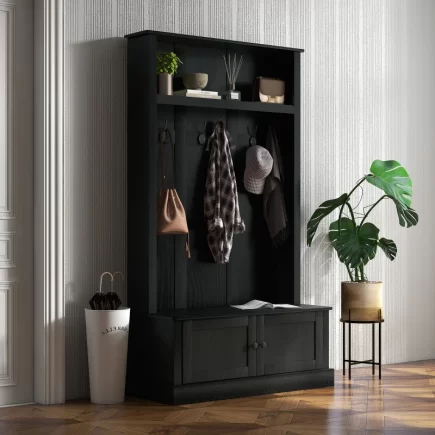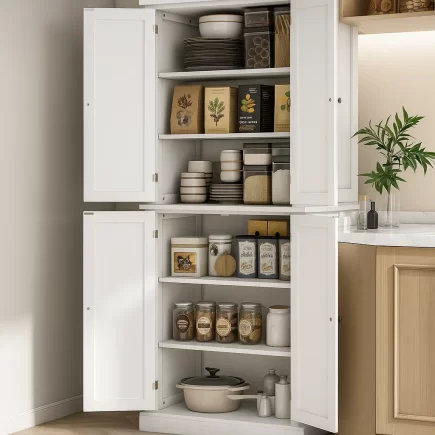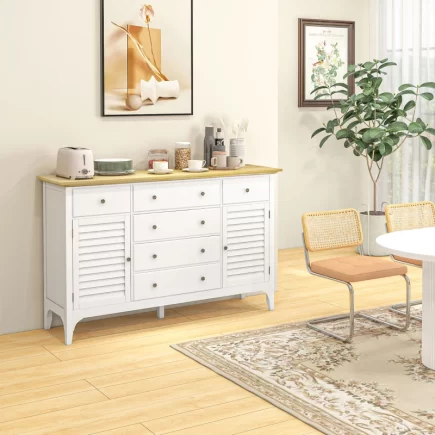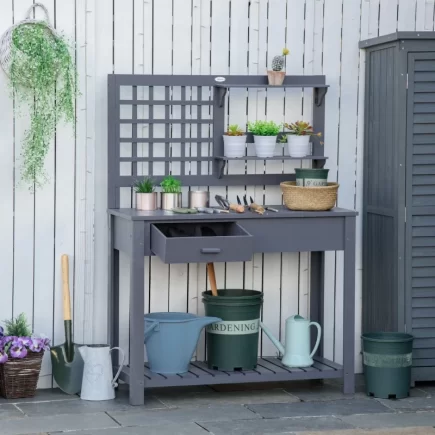
A coffee table is more than just a spot for books, drinks, or the remote. It serves as the centrepiece of your living space, tying together your furniture and style. But over time, even the most stunning wood coffee tables can begin to lose their charm. Scratches, water rings, a faded finish, or an outdated stain can make the surface look tired and worn. Instead of hiding it under a tablecloth or considering a replacement, there’s a smarter option: refinish it.
Step-by-Step Guide on Refinishing a Wood Coffee Table
Step 1: Gather the Right Tools and Materials

| Tool/Material | What It’s For |
| Orbital sander or sanding block | Removing old finish |
| Sandpaper (60, 120, 220 grit) | Rough to fine smoothing levels |
| Wood filler + putty knife | Fixing dents, scratches, gouges |
| Tack cloth or vacuum | Removing all the sanding dust |
| Wood stain or paint | Giving your table its new look |
| Polyurethane (or other sealant) | Final protective finish |
| Foam brush or lint-free cloth | Applying stain and sealer evenly |
| Painter’s tape | Protecting parts you don’t want to stain |
| Gloves, goggles, and mask | Safety while sanding and staining |
Step 2: Check the Condition of the Table
Before you dive into refinishing, take a few moments to inspect the table thoroughly.
1. Examine the Surface and Edges
Start by examining the surface and edges. Look for signs of wear such as deep scratches, water rings, dents, or any loose joints that may need repair. Pay close attention to corners, legs, and underneath the tabletop where hidden damage might be lurking.
2. Identify the Wood Type
Next, try to identify the type of wood you’re working with. Is it a hardwood like oak, maple, or walnut? Or a softwood such as pine or cedar? Knowing the wood type is important because it determines how you’ll approach sanding and refinishing in later steps.
3. Understand the Table’s Overall Condition
Taking time to understand your table’s condition will help you plan the process more effectively and avoid surprises down the line.
Step 3: Prepare the Work Area

Refinishing can get messy, so it’s important to set up your workspace properly before you begin.
- Pick a well-ventilated area such as a garage, workshop, or outdoor patio. Good airflow helps with sanding dust and drying time.
- Lay down a tarp or drop cloth to catch dust, wood shavings, and any drips from stain or finish.
- Use a stable, level surface to work on, something at waist height is ideal so you don’t strain your back.
- Plug in your sander and lay out all your tools and materials so everything is within easy reach.
Step 4: Clean the Coffee Table

Before you start sanding or stripping the old finish, make sure the table is completely clean.
What to Do:
- Dampen a soft cloth with warm water and add a small amount of mild dish soap.
- Gently wipe down the entire surface, paying extra attention to corners, crevices, and any sticky or greasy spots around the edges.
- Once clean, rinse the cloth and wipe again to remove any soap residue.
- Let the table dry completely before moving on to the next step.
Cleaning the table first ensures that dirt, grease, or leftover residue doesn’t interfere with sanding. It helps your sandpaper last longer and allows the new stain or finish to stick properly.
Step 5: Disassemble the Table (If Possible)
While not all coffee tables require disassembly, taking yours apart can make the refinishing process much easier and more precise.
Steps:
- Carefully flip the table over and check if the legs, drawers, or other components can be removed.
- Use a screwdriver to detach any removable parts.
- Place all screws, brackets, and hardware in a labelled zip-top bag so you don’t misplace anything.
- Set the detached parts aside and plan to refinish them separately for better control and even results.
Disassembling the table allows you to reach all surfaces without struggling around tight corners or awkward angles. It leads to a more polished, professional-looking finish and helps prevent accidental damage during sanding or staining.
Step 6: Sand the Table to Bare Wood

Sanding is the most important step in the refinishing process. It removes the old finish, smooths imperfections, and prepares the surface for a flawless new look.
How to Sand Properly
- Begin with a coarse grit sandpaper (60 or 80): Use an orbital sander for large, flat surfaces. For curves, edges, and corners, switch to a sanding block or hand sand for better control. This first pass removes the existing finish and evens out any dents or surface damage.
- Move to medium grit (120): This step smooths out the scratches left by the coarse grit and begins refining the surface.
- Finish with a fine grit (220): The final pass leaves the wood surface smooth and ready for staining or painting.
Sanding Tips:
- Always sand in the same direction as the wood grain. Sanding against the grain can leave permanent marks.
- After each sanding stage, clean the surface using a tack cloth or vacuum to remove dust before moving on.
- Be patient and go slowly. Rushing through this step can lead to swirl marks, uneven spots, or a patchy finish.
Step 7: Fill Any Cracks or Dents

Now that your table is sanded down to bare wood, it’s the perfect time to take care of any flaws you noticed earlier. Whether it’s a deep scratch, a small dent, or a tiny hole, fixing these imperfections will make a huge difference in the final look.
What to Do:
- Use a high-quality wood filler that matches your wood type or stain colour.
- Scoop a small amount onto a putty knife and press it firmly into the crack, dent, or hole. Smooth it out as evenly as possible.
- Allow the filler to dry completely. Drying times can vary, but most fillers are ready to sand within 1 to 2 hours.
- Once dry, lightly sand the patched areas using 220-grit sandpaper until they blend seamlessly with the rest of the surface.
Taking the time to fill and smooth out imperfections gives your refinished table a flawless, professional look. Skipping this step can cause blemishes to stand out, even after staining or painting.
Step 8: Apply the Stain or Paint
Now comes the exciting part, giving your coffee table a fresh new look. Whether you want to bring out the natural beauty of the wood or add a bold pop of colour, this step lets your personal style shine through.
Option A: Stain for a Natural Wood Finish

- Gently stir the stain using a stick. Avoid shaking the can, as it creates bubbles that can affect the finish.
- Dip a lint-free cloth or foam brush into the stain and apply it in smooth strokes, always following the direction of the wood grain.
- Let the stain sit for 5 to 15 minutes, depending on how rich you want the colour to be.
- Wipe away the excess stain with a clean cloth, again going with the grain.
- Allow the stained surface to dry completely for at least 24 hours in a dust-free space.
Before applying stain to the full table, test a small area underneath or on the back to make sure you’re happy with the colour.
Option B: Paint for Bold, Full Coverage

- If your table has a dark wood tone or you’re using a light paint colour, apply a primer first to help the paint stick and look even.
- Use a foam roller for flat areas and a small brush for corners or detailed spots. Apply the paint in thin, even coats.
- Let each coat dry thoroughly before applying the next. Rushing this step can lead to drips or streaks.
- You’ll likely need two or three coats to get full, consistent coverage.
Both methods can completely transform the look of your coffee table. Choose the one that best fits your space and style. Let me know if you’d like tips on choosing the right colour or finish.
Step 9: Seal with a Protective Finish
You’ve come this far, now it’s time to lock in all your hard work. Applying a protective finish is essential for keeping your coffee table looking great, even with everyday use. It guards against water rings, scratches, and general wear, so your refinished surface lasts for years.
Popular Sealers to Choose From
- Water-based polyurethane
This dries quickly, has a low odour, and gives a clear, natural finish that won’t yellow over time. - Oil-based polyurethane
Offers a warm, rich tone that enhances the wood grain. It takes longer to dry and has a stronger smell, so good ventilation is key. - Furniture wax
Best for a soft, matte look. It’s easy to apply but will need regular touch-ups to keep the protection intact.
How to Apply the Finish
- Use a foam brush or clean cloth to apply the finish in long, even strokes. Keep your motions smooth and consistent to avoid streaks or bubbles.
- Let each coat dry completely. Drying time varies by product, but most sealers need 12 to 24 hours before you can recoat.
- Once the first coat is dry, lightly sand the surface using 220-grit sandpaper. This helps the next coat stick better.
- Wipe away any sanding dust with a tack cloth, then apply your next coat.
- Repeat the process for a total of two to three coats, depending on the level of protection you want.
A good sealer doesn’t just protect, it enhances the look and feel of the table. Take your time with this step, and your coffee table will look like a professional makeover was done right at home.
Bring New Life to Your Furniture
Refinishing a wood coffee table isn’t just another home project. It’s a chance to slow down, get hands-on, and turn something worn into something wonderful. With a little patience and the right tools, you can completely transform a tired table into a piece that reflects your personal style and adds character to your space. Thinking about taking on another furniture piece. Whether it’s Wood Coffee Tables or another material, you can explore Aosom’s collection.
FAQs
1. What’s the best time of year to refinish furniture?
The best time to refinish furniture is spring or fall. These seasons offer mild temperatures and low humidity, allowing finishes to dry evenly without cracking or peeling. Avoid extreme heat or cold, which can disrupt curing and cause uneven results or poor stain absorption.
2. How to mix wood stains to create custom colors?
To create custom wood stain colors, mix two stains of the same base type (oil with oil, water with water). Start with small amounts and test on scrap wood. Adjust ratios gradually until you get your desired shade. Always stir thoroughly and apply evenly.
3. How to fix water damage on a wood coffee table?
Dry the table completely, then clean light stains with vinegar-water or baking soda paste. For deeper damage, sand the affected area, fill if needed, and re-stain. If warped, gently press with a cloth and low-heat iron. Always reseal after repairs for protection.
4. Is it possible to distress the table for a rustic or vintage look after refinishing?
Yes, you can distress a refinished table by sanding edges, dry brushing, or using tools to create dents. Focus wear on natural-use areas for authenticity. After distressing, apply a clear finish to protect the aged look without altering the texture or colour.

